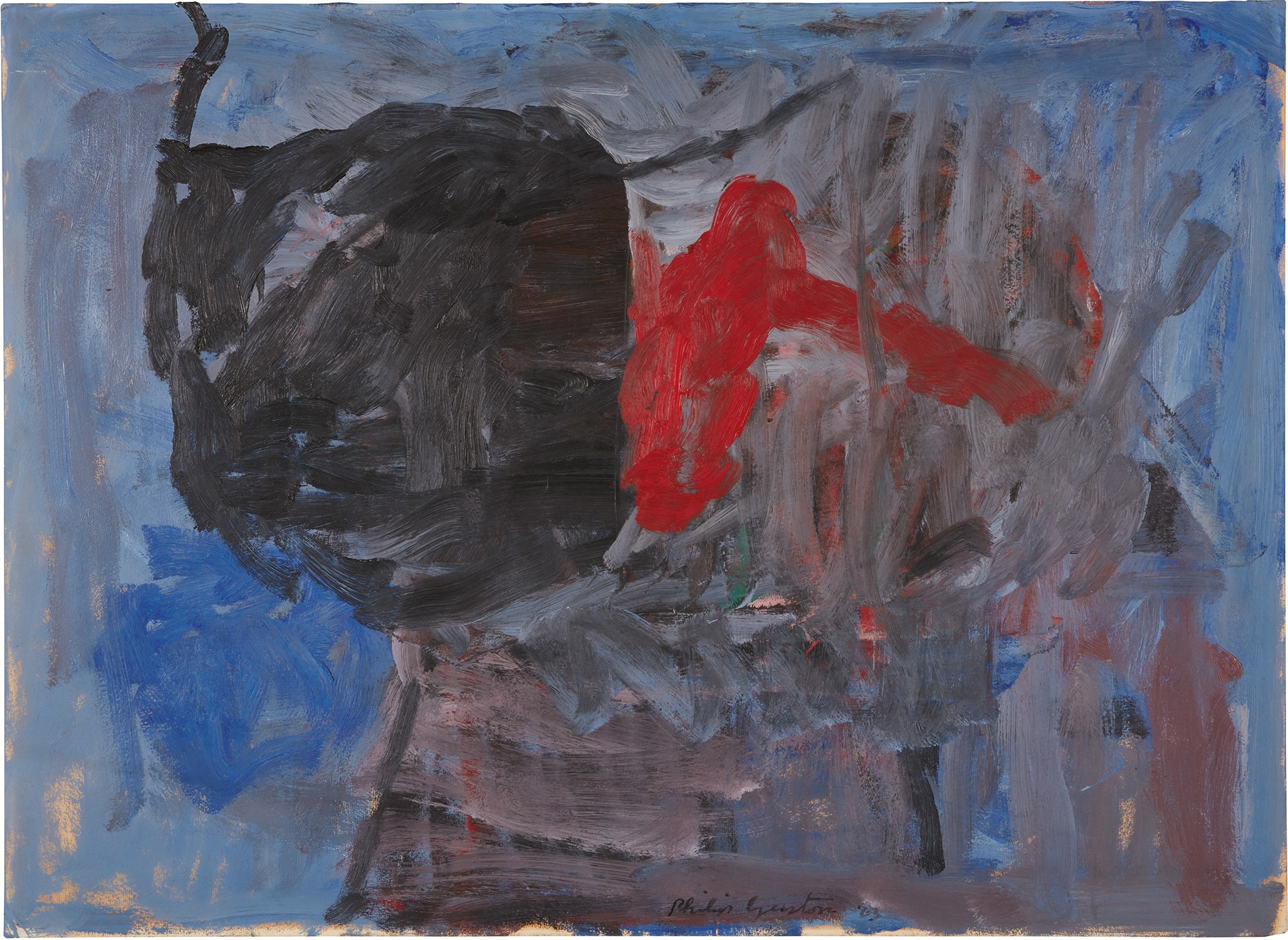

A Discerning Vision
Property from an Important Private Collection
Property from an Important Private Collection
117Ο◆
Philip Guston
Untitled
signed and dated "Philip Guston '63" lower center
oil on paper board mounted on Masonite
21 7/8 x 30 in. (55.5 x 76.2 cm.)
Executed in 1963.
Full-Cataloguing
Painted in a moody palette of restrained grays, deep blues, vibrant reds and bold black, Untitled, 1963, is an outstanding work created at the peak of Philip Guston’s abstract period, just a year after he became the very first artist that the Solomon R. Guggenheim, New York, would dedicate a solo retrospective to. Distinguished by its exceptional provenance, Untitled was notably gifted by Guston to the artist-photographer Renate Ponsold Motherwell in 1966 before making its way to the present collection via the eminent gallerist David McKee. Renate Ponsold Motherwell and her husband Robert Motherwell were close friends and peers of Guston's, who gifted the couple a number of works in the mid 1960s. Like-minded artists who continuously challenged the canon with practices that defied easy categorization, Guston and Robert Motherwell had notably been among those artists who left the Sidney Janis Gallery in 1962 in protest over the Pop art exhibition that the gallery mounted and the shift towards the commercialization of art that this represented. Speaking of the close peer-to-peer relationships among the artists associated with the New York School, Untitled pays tribute to an era that forever changed the course of art history.
Building on over a decade of Guston’s abstract practice, Untitled represents the culminating point of a shift in his stylistic idiom that had been set in motion in the mid 1950s. While Guston had garnered widespread acclaim for his “abstract impressionist” works – characterized by short brushstrokes, interlacing horizontal and vertical lines and a luminous color palette – throughout the decade his ethereal abstractions gradually transformed into broodier compositions. Influenced by the existential writings of Franz Kafka and Jean-Paul Sartre, by the early 1960s Guston embarked upon a distinct formal shift in his practice. His works are imbued with increasingly somber, anxious tones as dark, ominous forms began to crowd his paintings; his palette now reminiscent of the darker hues used by Venetian painters such as Tintoretto and Titian and in heavy impasto.
Representing the culmination of Guston’s abstract practice, Untitled exemplifies the emergence of solid, ominous forms that prefigure the artist’s return to representational modes in the late 1960s. The central triangular form specifically foreshadows Guston’s signature hood motif. Oscillating between creation and erasure, Guston creates a dense composition in which the circular blue and black masses suggest a sense of three-dimensionality. As Michael Kimmelman observed of this transitional period in Guston’s practice, "these soulful abstractions search out shapes they can't yet define. They have the rough, barely muffled anger of raised voices approaching from the other side of a closed door" (Michael Kimmelman, "Art Review: Anxious Liberator of an Era's Demons", The New York Times, October 31, 2003, p. E37). While Guston would continue to enjoy critical acclaim for his abstract work – notably receiving a survey show at the Jewish Museum, New York, in 1966 – by the late 1960s he would indeed abandon abstraction only to radically, and controversially, re-emerge as figurative painter.
Building on over a decade of Guston’s abstract practice, Untitled represents the culminating point of a shift in his stylistic idiom that had been set in motion in the mid 1950s. While Guston had garnered widespread acclaim for his “abstract impressionist” works – characterized by short brushstrokes, interlacing horizontal and vertical lines and a luminous color palette – throughout the decade his ethereal abstractions gradually transformed into broodier compositions. Influenced by the existential writings of Franz Kafka and Jean-Paul Sartre, by the early 1960s Guston embarked upon a distinct formal shift in his practice. His works are imbued with increasingly somber, anxious tones as dark, ominous forms began to crowd his paintings; his palette now reminiscent of the darker hues used by Venetian painters such as Tintoretto and Titian and in heavy impasto.
Representing the culmination of Guston’s abstract practice, Untitled exemplifies the emergence of solid, ominous forms that prefigure the artist’s return to representational modes in the late 1960s. The central triangular form specifically foreshadows Guston’s signature hood motif. Oscillating between creation and erasure, Guston creates a dense composition in which the circular blue and black masses suggest a sense of three-dimensionality. As Michael Kimmelman observed of this transitional period in Guston’s practice, "these soulful abstractions search out shapes they can't yet define. They have the rough, barely muffled anger of raised voices approaching from the other side of a closed door" (Michael Kimmelman, "Art Review: Anxious Liberator of an Era's Demons", The New York Times, October 31, 2003, p. E37). While Guston would continue to enjoy critical acclaim for his abstract work – notably receiving a survey show at the Jewish Museum, New York, in 1966 – by the late 1960s he would indeed abandon abstraction only to radically, and controversially, re-emerge as figurative painter.